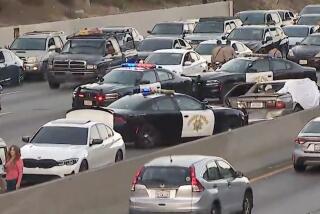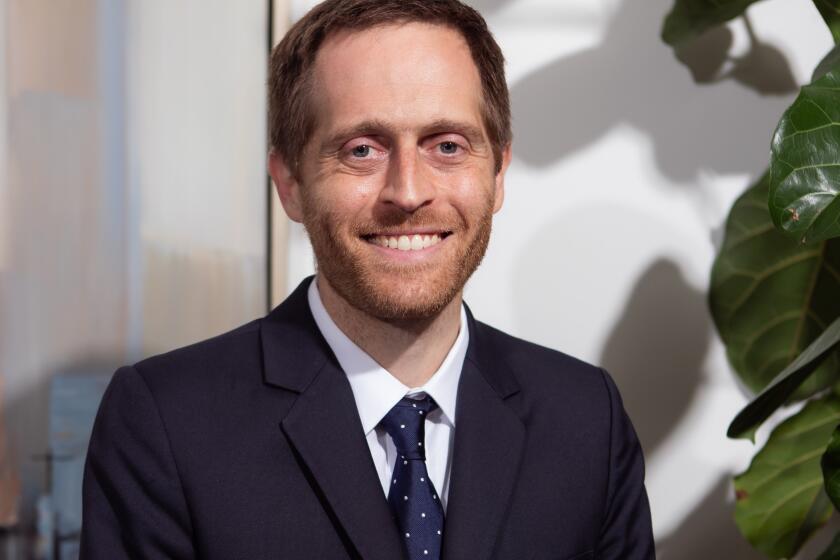Copycats Feared in Freeway Shootings
- Share via
Manny Padilla didn’t need the recent series of freeway shootings that have left four men dead and one wounded to understand how tense the roads can be.
“My sister-in-law actually had a weapon pulled on her on an Inland Empire highway,” said Padilla, chief of the California Highway Patrol’s Los Angeles County division. “She backed off, got the license plate and called it in.”
Padilla said his officers were noticing that as freeways got more congested, the frustrations of the daily commute were changing the way motorists behaved -- and not for the better.
“It has grown worse over the years. People behind the wheel seem less courteous, less patient and more willing to be aggressive,” he said. “People seem just more agitated, and that makes for confrontations.”
Investigators have found no links among the five shootings, which took place across a wide expanse of Southern California.
Still, the shootings have occurred so close together that Padilla and other officials fear the incidents have created their own momentum. Moreover, they said, the shooters may had been emboldened by the fact that no arrests had been made in any of the cases.
“I don’t think it is safe to say these are all the result of road rage,” Padilla said. “There may well be copycats.... We need to stop these incidents from occurring.”
The first of the recent freeway assaults occurred March 12 when a Fontana engineer was shot in the head and killed about 1 p.m. on the northbound Costa Mesa Freeway in Tustin. The most recent shooting took place on the same stretch of freeway early Sunday when a 32-year-old Tustin man was shot in the neck and wounded.
The CHP has responded by increasing patrols on that freeway as well as on the Harbor Freeway, where two of the other attacks occurred.
The CHP said there were 38 reported incidents of guns being brandished on California freeways in 2002. (The agency stopped recording the number of such incidents that year.)
But CHP Sgt. Troy Lukkes said it was “highly unusual” to have so many fatalities in such a short period of time. “If we get one or two of these shooters behind bars, it will shut down these incidents,” he said.
Some experts said it was important to view the shootings in the larger context, noting that such violence remained rare.
“The fact that we’ve heard about several incidents, which are very likely isolated, doesn’t mean it’s a trend or anything to worry about,” said USC sociology professor Barry Glassner, author of “The Culture of Fear: Why Americans Are Afraid of the Wrong Things.”
“There’s been violence between motorists for a long time, probably since the Model T, but now we have terms for it like ‘road rage.’ So it sounds more frightening to us.”
This is not the first time random roadway shootings in Southern California have shaken drivers.
In the summer of 1987, more than two dozen shootings on the roads -- many involving aggressive driving on the part of one or both drivers -- alarmed commuters, creating what CHP officers said was “hysteria out of proportion.”
Authorities blamed copycats for many of the 1987 shootings that left at least five dead and several other people seriously wounded.
At the time, officers said shooters seemed emboldened by media coverage and the difficulty authorities had in tracking down mobile assailants.
The gunfire drove some Southern Californians to post conciliatory signs in their cars, inquire about bulletproof glass or even arm themselves.
Since then, there have been other periods of shootings, including several in 1998.
Erratic driving on the freeways is considered a factor in such shootings -- but not the only one.
The CHP recorded a 17% increase statewide in reckless driving citations in the last few years, from 1,254 in 2000 to 1,468 in 2003, the latest year for which data were available.
Still, authorities said that they didn’t know enough about the most recent shootings to determine motives.
Three attacks took place in the early afternoon and the two others were in the early morning.
Authorities say car-to-car shootings are particularly difficult to investigate; there are relatively few witnesses because people keep their eyes on the road. Moreover, assailants can easily speed away.
A car-to-car shooting on the Hollywood Freeway that killed a 20-year-old Valley College student in March 2004 remains unsolved despite the release of a composite drawing of a possible suspect and a description of the car.
The most recent series of shootings began when Jake Tuason, a 26-year-old Fontana engineer, was shot in the head about 1 p.m. March 12 on the Costa Mesa Freeway.
The bullet was fired from an adjacent car in the carpool lane, and officers have no suspects or a clear idea of what happened.
Two weeks later, Long Beach college student Michael Livingston, 20, was gunned down about 2 p.m. March 29 in his silver Chevrolet Camaro in heavy traffic on the Harbor Freeway.
Despite public pleas from the family for witnesses to come forward, the investigation has yielded few clues except a possible description of the gunman’s vehicle: a dark gray Lincoln Town Car with tinted windows.
About five miles away on the same freeway, car salesman James Wiggins, 47, was fatally shot about 2:10 p.m. April 13 while he and a friend were on the way to Bible study.
The passenger told detectives there was no confrontation or gestures before bullets tore through the car windows.
Ricky Smith, 32, of San Bernardino was killed about 2:30 a.m. Friday when his sport-utility vehicle was riddled with bullets by someone shooting out of a passing Chevrolet Monte Carlo on the 60 Freeway in Riverside.
Then a Tustin man was shot in the neck about 1:45 a.m. Sunday on the same part of the Costa Mesa Freeway where Tuason was killed. The unidentified victim was able to drive himself to a hospital about three miles away and was expected to live.
Padilla said his sister-in-law took the right approach when confronted by a gun-waving motorist. He said people who find themselves in that situation should avoid confrontation and, if possible, report the incident to authorities immediately.
“Don’t get suckered into it with another driver. Don’t engage. Remove yourself from the situation,” Padilla said. “She backed off.”
Times staff writers Jennifer Delson and Megan Garvey contributed to this report.
More to Read
Sign up for Essential California
The most important California stories and recommendations in your inbox every morning.
You may occasionally receive promotional content from the Los Angeles Times.














